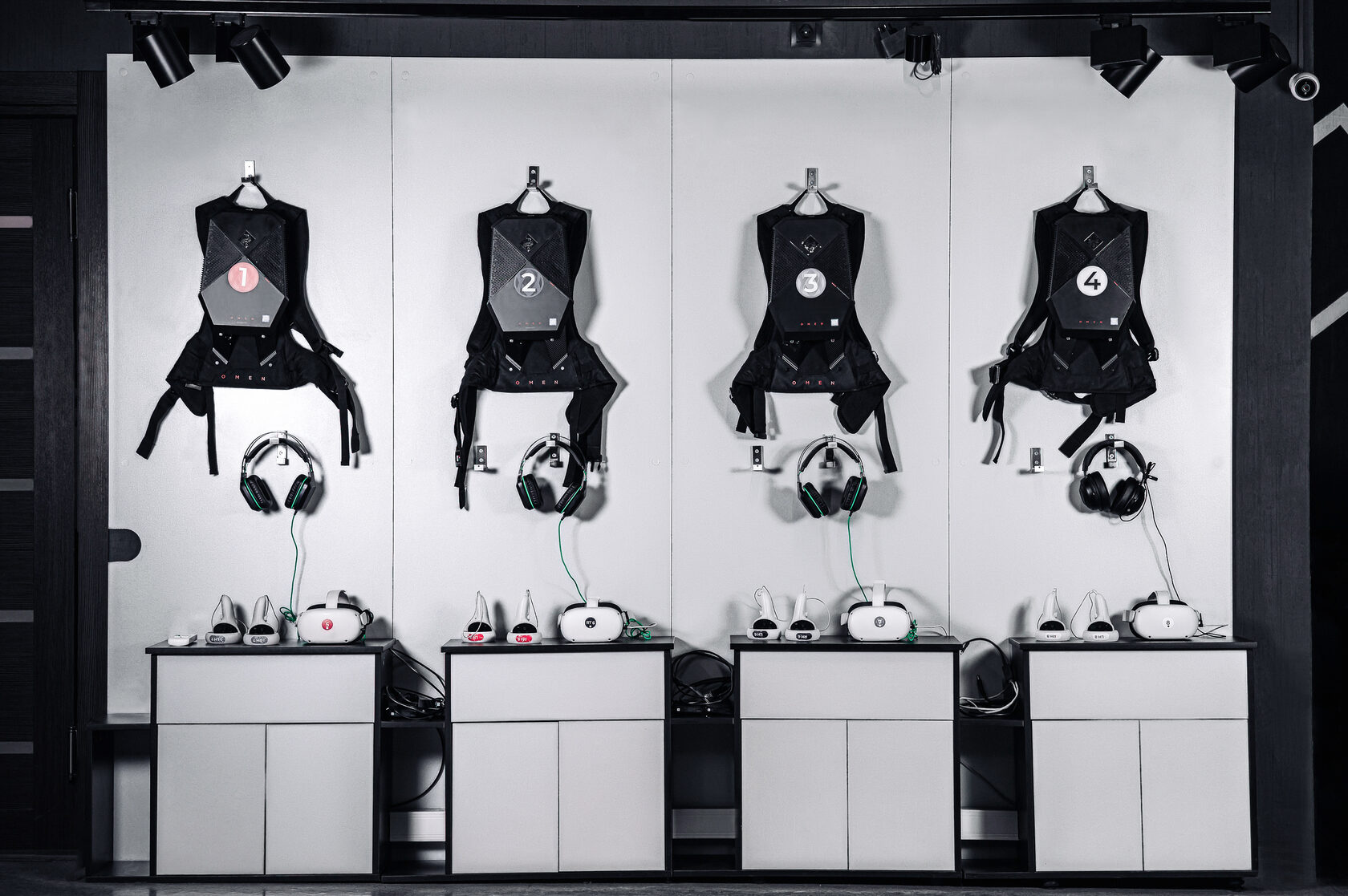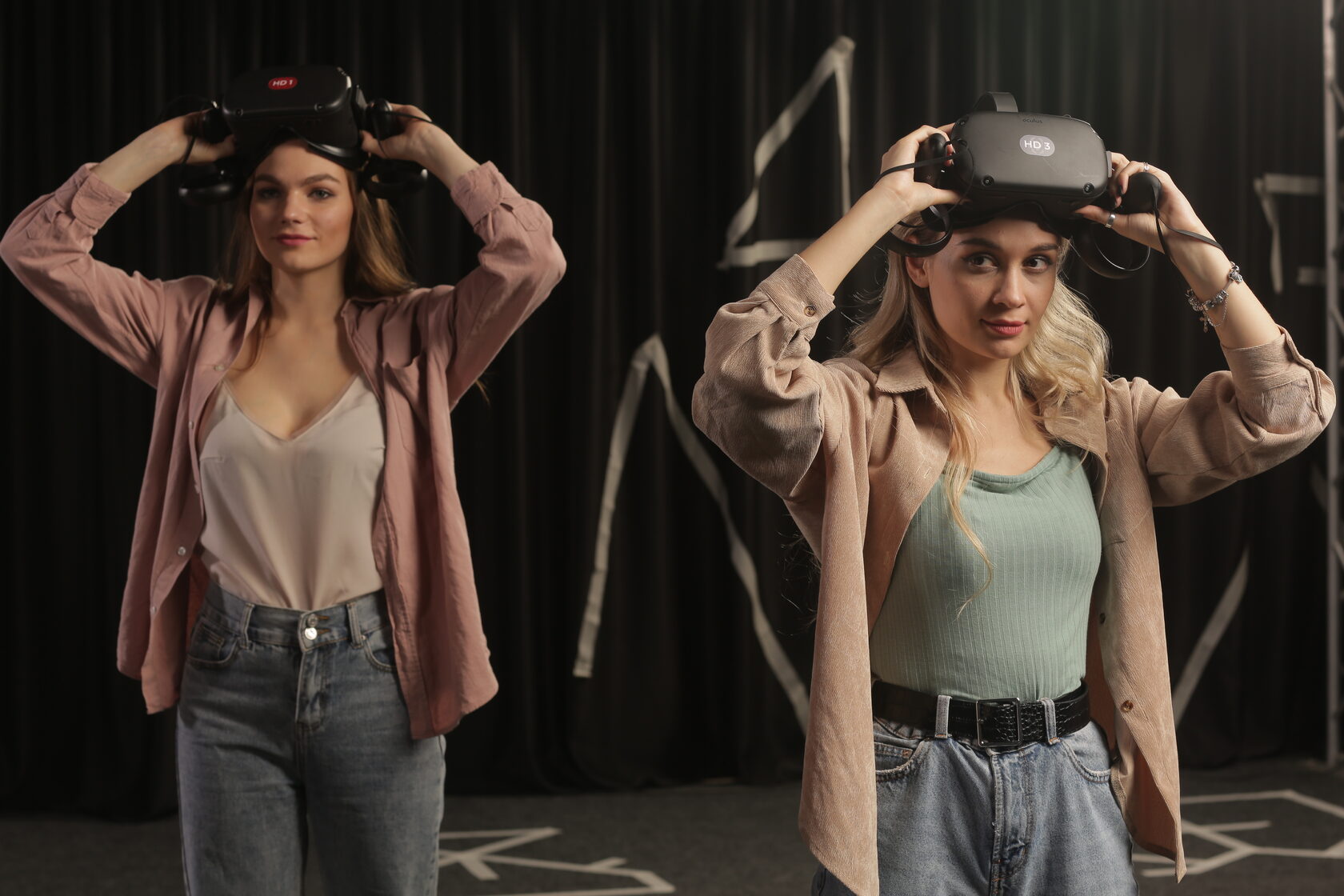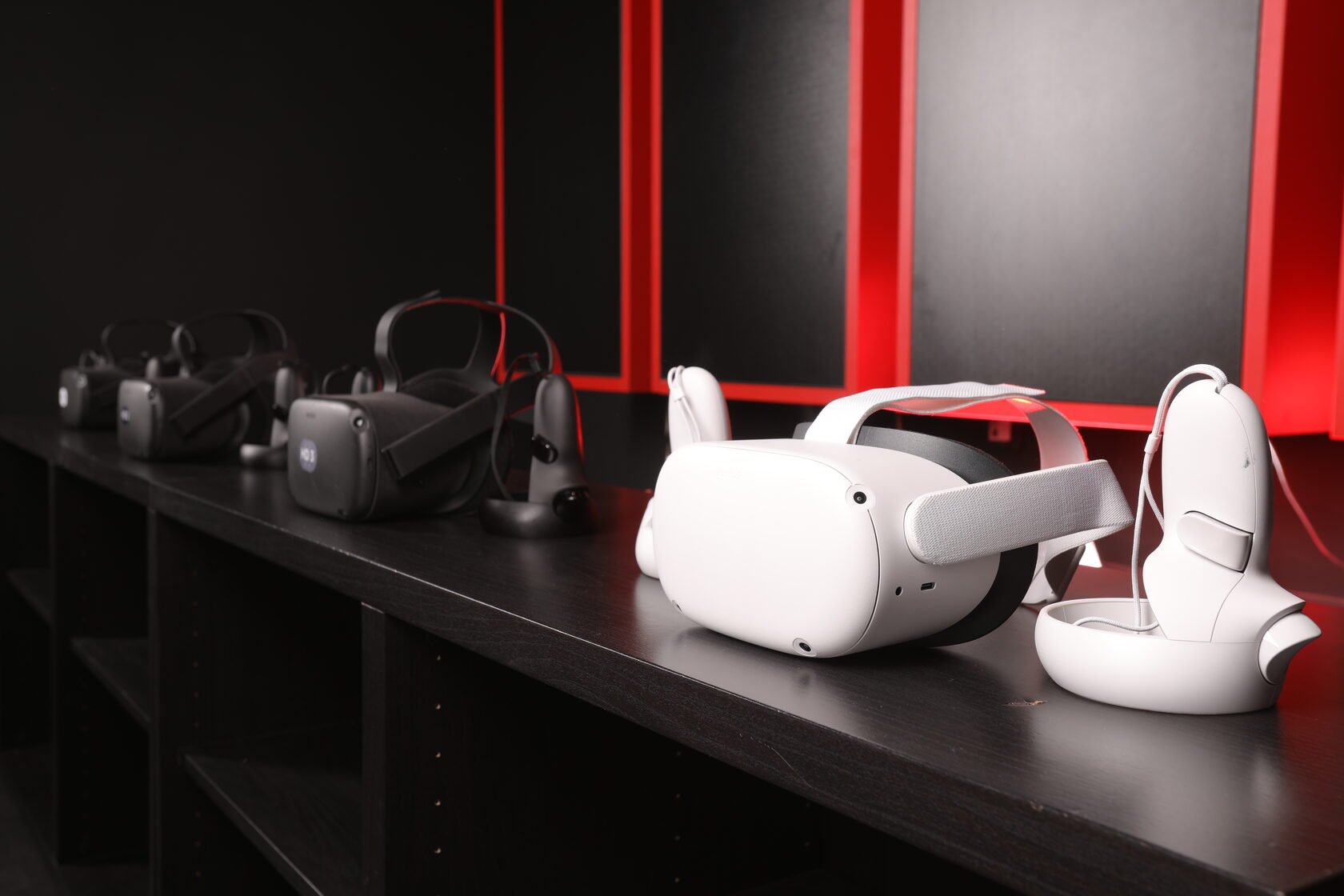Calculate the financial model
Рассчитать финансовую модель
Рассчитать финансовую модель
ORDER AN ANVIO GAME ZONE
Остались вопросы?
STILL HAVE QUESTIONS?
This website uses cookies to ensure you get the best experience
Expert Talk: The Evolution of the LBE VR Industry
The history of the location-based virtual reality entertainment (LBE VR) industry is a thrilling journey of innovation and technological breakthroughs. Since its foundation, ANVIO VR has become a significant player in the VR entertainment sector, acting not only as an operator of turnkey business solutions, but also as a developer of next-generation VR technologies.

In this article, Maxim Karandashov, Chief Technology Officer (CTO) at ANVIO VR, explores the technological advancements in virtual reality entertainment. With a degree in software engineering, Maxim has been a part of the ANVIO VR team for over six years. Prior to joining ANVIO VR, he worked on computer vision and data analysis systems.
How did the LBE VR industry start?
The release of the Oculus Rift CV1 virtual reality headset, acquired by Facebook, and the emergence of the first-generation HTC Vive, radically transformed the VR industry. Without these headsets, the virtual world as we know it today would not exist. They played a crucial role in shaping and advancing VR technology.
The Oculus Rift CV1 and HTC Vive were wired headsets that required a high-performance computer with a powerful graphics card. Each headset came with a set of sensors that connected to the computer or a power outlet. Most importantly, they offered a full-fledged device that you could wear to experience genuine VR content.
Thanks to their lightweight design, weighing only a few hundred grams, and their decent resolution, players would become fully immersed in virtual reality. The introduction of these headsets unveiled a new technology, prompting people to explore its potential uses. This marked a turning point for the VR industry, leading to the development of various startups in the B2B segment. The headsets opened up new opportunities for creating unique virtual worlds that are impossible to experience in real life, becoming a unique selling proposition. From 2018 to 2020, the first VR attractions began to appear prominently in shopping malls. These attractions were set up as kiosks, they primarily utilized the HTC Vive headset connected by wires.
A few years later, people began to consider the need to develop wireless devices for creating free-roam VR games, where players could freely move around the gaming area and interact with other participants. This marked a significant breakthrough in VR game development, leading to the emergence of the first free-roam VR projects such as Zero Latency, ANVIO, The Void, and others.
The Oculus Rift CV1 and HTC Vive were wired headsets that required a high-performance computer with a powerful graphics card. Each headset came with a set of sensors that connected to the computer or a power outlet. Most importantly, they offered a full-fledged device that you could wear to experience genuine VR content.
Thanks to their lightweight design, weighing only a few hundred grams, and their decent resolution, players would become fully immersed in virtual reality. The introduction of these headsets unveiled a new technology, prompting people to explore its potential uses. This marked a turning point for the VR industry, leading to the development of various startups in the B2B segment. The headsets opened up new opportunities for creating unique virtual worlds that are impossible to experience in real life, becoming a unique selling proposition. From 2018 to 2020, the first VR attractions began to appear prominently in shopping malls. These attractions were set up as kiosks, they primarily utilized the HTC Vive headset connected by wires.
A few years later, people began to consider the need to develop wireless devices for creating free-roam VR games, where players could freely move around the gaming area and interact with other participants. This marked a significant breakthrough in VR game development, leading to the emergence of the first free-roam VR projects such as Zero Latency, ANVIO, The Void, and others.
What technologies were used at that time?
The HTC Vive headset was not suitable for use in large rooms due to the lack of integration with external tracking systems. The Oculus Rift model worked great in a spacious area, moreover, the device offered the capability to connect to an external tracking system.
At first, we adopted a solution from OptiTrack, a company specializing in motion capture technology similar to what's used in Hollywood. An example of motion capture is footage from the filming of the movie "Pirates of the Caribbean," where Johnny Depp talks against a green screen. Our company used the principles of this technology, but it required expensive equipment. Although the equipment was costly — about $150,000 for four players — it allowed us to create large game zones and include many players in games at once.
At first, we adopted a solution from OptiTrack, a company specializing in motion capture technology similar to what's used in Hollywood. An example of motion capture is footage from the filming of the movie "Pirates of the Caribbean," where Johnny Depp talks against a green screen. Our company used the principles of this technology, but it required expensive equipment. Although the equipment was costly — about $150,000 for four players — it allowed us to create large game zones and include many players in games at once.
Development for such equipment was quite peculiar. Every six months, we faced the need to update the game engine, which sometimes caused delays because of errors. ANVIO used OptiTrack for around six months. After that, we started looking for ways to simplify and reduce the cost of the process, since there was no return on financial investment.
What made it possible to reduce the cost of the location?
As technology advanced, Valve introduced the second generation of tracking, forming the basis for the creation of the HTC Vive Pro headset in collaboration with HTC. The wired version of the model cost $1,500. The new devices, paired with a gaming backpack and updated tracking system from Valve, allowed us to nearly halve the cost of a game zone. Expenses dropped to approximately $50,000 for a set accommodating six players. Alongside improvements in headset screen quality, transitioning to SteamVR software simplified both development and maintenance processes. As a result, in conjunction with Valve's second-generation tracking, ANVIO managed to expand the play area to around 100 square meters. The cost per square meter decreased by half compared to the previous version.

Transitioning from OptiTrack to HTC Vive Pro presented certain challenges. To enable full-body tracking technology, sensors were attached to players, and controllers were linked to the player's headset and backpack via Bluetooth. Increasing the number of Bluetooth devices per square meter led to connectivity issues. ANVIO was tasked with resolving this connection problem to accommodate more players while retaining full-body tracking capabilities.
Our developers excelled in maximizing the utility of HTC's full-body sensors. They devised a system for distributing Bluetooth connectors, which helped accommodate a large number of game participants. We managed to overcome these challenges successfully within 6-7 months and became one of the few in the world to offer such a solution commercially. Additionally, we configured the tracking system from Valve in a way that allowed us to expand the gaming area to 100 square meters, exceeding standard limitations by 10%.
Our developers excelled in maximizing the utility of HTC's full-body sensors. They devised a system for distributing Bluetooth connectors, which helped accommodate a large number of game participants. We managed to overcome these challenges successfully within 6-7 months and became one of the few in the world to offer such a solution commercially. Additionally, we configured the tracking system from Valve in a way that allowed us to expand the gaming area to 100 square meters, exceeding standard limitations by 10%.
How did you transition to Oculus Quest headsets?

The LBE VR market continued to seek more affordable solutions. The cost of a $50,000 equipment set for six players was still too high. A turning point came with the release of the Oculus Quest 1. This headset introduced inside-out tracking, eliminating the need for external sensors. The device could independently determine the player's position in space.
With the introduction of Wi-Fi 5.1 access points, the Quest unlocked new possibilities. The range of wireless Internet allowed for the transmission of images from the gaming computer to the player's headset almost in real-time, with minimal latency. Developers were able to reduce the latency to 30-50 milliseconds, several times lower than before.
This allowed us to initiate the next transition. Using Oculus headsets, standard gaming computers, streaming software, and Wi-Fi access points, we combined everything to create a game zone. The cost of the Oculus Quest dropped to $300-350 compared to the HTC Vive Pro. We managed to reduce the price of a game zone from $50,000 to $17,000, nearly three times cheaper. The full-body tracking was based on a special algorithm that determined the position of the player's hands, feet, and head. Our developers successfully implemented the new system much earlier, even before its integration into Meta's Horizon project.
The cost of the equipment remained high but was significantly more affordable than before. The new headset was lighter; however, the initial Oculus models had a poorly designed mount, making them less comfortable than the HTC Vive Pro. There were also issues with Wi-Fi quality and unsuitable access points. Developers encountered challenges when using the headsets for group sessions. While the tracking system was not perfect, calibration was simpler compared to the HTC.
With the introduction of Wi-Fi 5.1 access points, the Quest unlocked new possibilities. The range of wireless Internet allowed for the transmission of images from the gaming computer to the player's headset almost in real-time, with minimal latency. Developers were able to reduce the latency to 30-50 milliseconds, several times lower than before.
This allowed us to initiate the next transition. Using Oculus headsets, standard gaming computers, streaming software, and Wi-Fi access points, we combined everything to create a game zone. The cost of the Oculus Quest dropped to $300-350 compared to the HTC Vive Pro. We managed to reduce the price of a game zone from $50,000 to $17,000, nearly three times cheaper. The full-body tracking was based on a special algorithm that determined the position of the player's hands, feet, and head. Our developers successfully implemented the new system much earlier, even before its integration into Meta's Horizon project.
The cost of the equipment remained high but was significantly more affordable than before. The new headset was lighter; however, the initial Oculus models had a poorly designed mount, making them less comfortable than the HTC Vive Pro. There were also issues with Wi-Fi quality and unsuitable access points. Developers encountered challenges when using the headsets for group sessions. While the tracking system was not perfect, calibration was simpler compared to the HTC.
How did the equipment evolve further?

About a year after its predecessor, the Oculus Quest 2 headset hit the market. We started exploring the possibility of adapting our content for the new device. The Oculus Quest 2 was standalone, with its own operating system, eliminating the need for a connection to a gaming computer. In the first year after its release, ANVIO developers were unable to adapt their content to the device due to limitations in processing power and the graphics card. At that time, it was not possible to modify any of its operating system settings to overclock the Central Processing Unit (CPU) or increase power consumption. Only in the second year of the Oculus Quest 2's existence did its developers manage to boost the device's CPU performance by 20-30%, enhancing its capabilities as it began facing competition from ByteDance's Pico 4 headset.
At that point, we managed to effectively adapt our flagship game, CityZ 1, to the Oculus Quest 2. It wasn't a walk in the park, but it also wasn't as challenging as I anticipated. However, we faced difficulties with our other games because of their high-quality graphics, requiring considerable effort to streamline them for the device.
As of today, virtual reality has achieved remarkable heights. In just a few years, the industry has advanced so far that wired headsets and gaming backpacks now appear outdated. Wireless VR games have become the norm in the LBE VR market. Various companies offer a diverse range of solutions, including streaming and standalone headsets. This format has already been prevalent in the VR market for nearly three years.
At that point, we managed to effectively adapt our flagship game, CityZ 1, to the Oculus Quest 2. It wasn't a walk in the park, but it also wasn't as challenging as I anticipated. However, we faced difficulties with our other games because of their high-quality graphics, requiring considerable effort to streamline them for the device.
As of today, virtual reality has achieved remarkable heights. In just a few years, the industry has advanced so far that wired headsets and gaming backpacks now appear outdated. Wireless VR games have become the norm in the LBE VR market. Various companies offer a diverse range of solutions, including streaming and standalone headsets. This format has already been prevalent in the VR market for nearly three years.
What's your vision for the future of the LBE VR industry?

The future of LBE VR lies in large gaming centers, delivering top-notch service and catering to visitors of all ages. It's about amusement parks with facilities spanning at least five hundred square meters. At the heart of LBE VR are its offerings of engaging content and immersive environments, providing opportunities for socializing with friends or colleagues, enjoying gameplay, celebrating special occasions like birthdays, and simply having a great time.
What advancements do you foresee for VR technologies in the near future?
In the upcoming year, we don't anticipate any revolutionary changes in VR headsets. Instead, companies will be incorporating technologies akin to those found in the Meta Quest 3 device into their offerings. The Meta Quest 3 headset boasts an upgraded Snapdragon processor, enhanced pancake lenses, and a more compact design. These structural improvements aim to maximize the comfort and accessibility of the virtual reality experience for users.

At present, the VR industry heavily relies on Qualcomm's hardware. The vast majority of new developments in this field are contingent upon the chips that this brand will introduce in the near future. Key competitors like the Meta Quest 3, Pico 4, and HTC Vive Focus 3 all utilize Snapdragon XR2 or Snapdragon XR2+ processors. Currently, there are no other manufacturers capable of providing a central processor with the necessary technical specifications for virtual reality operations. The progression of the VR industry hinges on agreements between major players and Qualcomm on a global scale.
It is predicted that over the next 3-5 years, the industry will undergo significant changes related to the reduction in size and increased comfort of VR headsets. Achieving the ideal scenario seems possible, where a person can put on lightweight glasses only 1-2 centimeters thick and instantly immerse themselves in the gaming world, interacting with other participants. Technologies are confidently moving in this direction.
It is predicted that over the next 3-5 years, the industry will undergo significant changes related to the reduction in size and increased comfort of VR headsets. Achieving the ideal scenario seems possible, where a person can put on lightweight glasses only 1-2 centimeters thick and instantly immerse themselves in the gaming world, interacting with other participants. Technologies are confidently moving in this direction.
Is the VR entertainment sector still attractive to investors?
Given the rapid rise in the popularity of virtual reality entertainment and a notable drop in the cost of required equipment, today presents a favorable moment for investing in the LBE VR business. New technological solutions simplify installation, while growing interest in free-roam VR sets the stage for industry growth. Key innovations have already been successfully integrated and are operating effectively. This opens up opportunities for promising financial investments in virtual reality.



